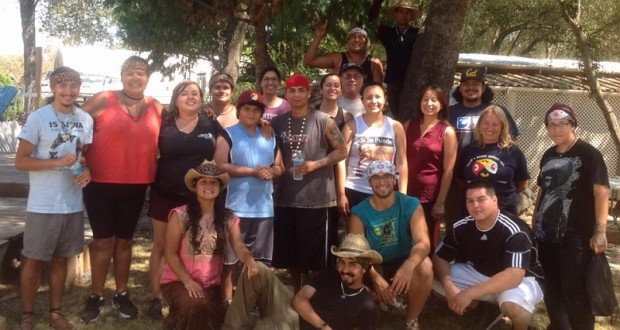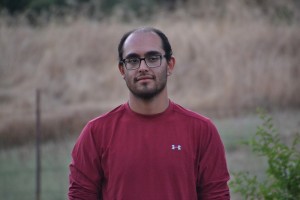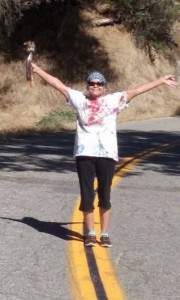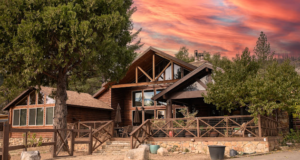NORTH FORK — Amid the sounds of native drums and prayers offered up for a safe journey and the experience of unity, a North Fork family played host to those on a spiritual journey this week, celebrating with runners on their way from Alaska to Panama as part of the Peace & Dignity Journey 2016.
“Peace and Dignity Journeys” is an Indigenous First Nation organization that invites the participation of native and non-native individuals who are strongly committed to the preservation of Native American culture. (http://peaceanddignity.org/about/)
Bill and Jennifer Elliot, along with their extended family and local tribal citizens, welcomed 10 runners to their home on Road 222 on Tuesday evening, after their 50-mile run from Mariposa.
Daniel Mejia, 26, of Patterson, Calif., shared his story, and that of Peace and Dignity Journeys — a project that seeks to unite indigenous peoples throughout North and South America.
“The Journeys happens every four years,” says Daniel. “One group starts in the northern part of Alaska, another starts in Argentina, and we meet in the middle, this year in Panama City, Panama.”
This is Daniel’s second time participating in the run. He ran for two months during the 2012 event, but plans to make the entire 5,000-plus-mile run this year, taking on a larger role as an organizer and posting the group’s progress on Facebook.
The beginnings of the run date back to 1990, when over 200 representatives of indigenous nations from throughout the western hemisphere met for the first time in Quito, Ecuador.
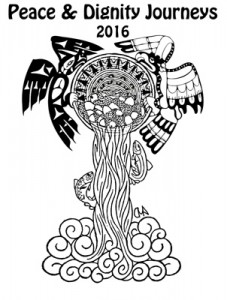 “There was discussion about a prophesy called the Eagle and the Condor,” says Daniel. “It talks about how the eagle represents North America, and the condor, South America. The legend says that when the eagle of the north and the condor of the south meet in the land of the Quetzal – which is Central America – there will be unity amongst all people.”
“There was discussion about a prophesy called the Eagle and the Condor,” says Daniel. “It talks about how the eagle represents North America, and the condor, South America. The legend says that when the eagle of the north and the condor of the south meet in the land of the Quetzal – which is Central America – there will be unity amongst all people.”
The 1990 meeting, says Daniel, involved a conversation about the upcoming quincentennial of Columbus landing in the Americas.
“They had a discussion about the current state of indigenous peoples and how do we feel about the quincentennial of Columbus; if we had a message for the world what would we want to tell them.
“And it just so happened there was a constituency from Chicago talking about wanting to have a spiritual run across North America. At the same time, different communities were talking about this prophesy of the eagle and the condor, and they put those two together and talked about one group starting on one side of the world and one starting on the other, and meeting together to fulfill that prophesy and bring it to life.”
And so was born the Peace & Dignity Journeys.
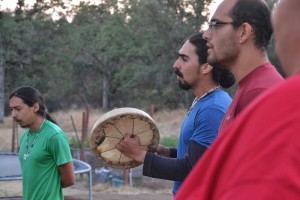 “Everything about the run is part of ceremony,” says Daniel. “We say that as soon as you are part of the run, you are in ceremony 24/7. There are certain things that we do during the day that are more protocol, signifying more of the ceremony. We smudge and we have a circle every day.”
“Everything about the run is part of ceremony,” says Daniel. “We say that as soon as you are part of the run, you are in ceremony 24/7. There are certain things that we do during the day that are more protocol, signifying more of the ceremony. We smudge and we have a circle every day.”
They also have specific and reverent ways of opening and closing their bundles – which contain items of spiritual significance to each participant – and of handling and honoring the staffs they carry.
“There is a specific way that we run as well. We consider it all ceremony.”
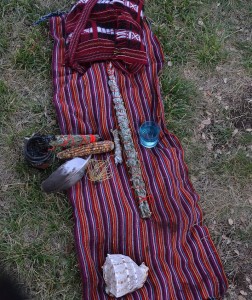 After a 4-day ceremony in San Diego on April 12, Daniel and six other runners made the long drive to Sutton, Alaska, where they set out on May 1st. They have a support vehicle with them – a 15-passenger van that has been dubbed Xiuhtecuhtli – which means God of Fire in the Nahuatl (Aztec) language.
After a 4-day ceremony in San Diego on April 12, Daniel and six other runners made the long drive to Sutton, Alaska, where they set out on May 1st. They have a support vehicle with them – a 15-passenger van that has been dubbed Xiuhtecuhtli – which means God of Fire in the Nahuatl (Aztec) language.
The run itself is carried out as a kind of relay, and runners can join and stop at distances of their choosing.
“It’s a system that’s been developed that helps us cover a lot of ground,” says Daniel. “The requirement is that every step between communities needs to be run or walked. We use markers which are basically good-sized rocks wrapped in tape and fabric, like flags, to designate where one runner started and where the next runner needs to end.”
Participants “lay down their prayers” in different ways, says Daniel, and part of staying focused on ceremony is avoiding distractions.
“Running through city, it’s easy to get distracted. Even having technology around can cause distraction.”
As part of his role as an organizer, Daniel needs to keep a cell phone with him to help with navigation and communication.
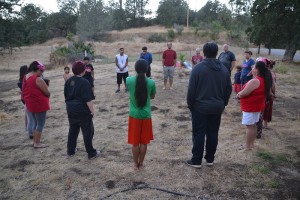 “Sometimes being on the phone feels like it takes me away from the ceremony. At the end of the day it helps us communicate with our families that some of us don’t see for months, but we try to find that balance. Also it’s just part of what we’re doing; when we go to communities, it’s part of the conversation – how do we balance the times that we live in with our ancestral knowledge and traditions.”
“Sometimes being on the phone feels like it takes me away from the ceremony. At the end of the day it helps us communicate with our families that some of us don’t see for months, but we try to find that balance. Also it’s just part of what we’re doing; when we go to communities, it’s part of the conversation – how do we balance the times that we live in with our ancestral knowledge and traditions.”
A large part of the Journey is to have folks from each community run with them while they’re passing through that community.
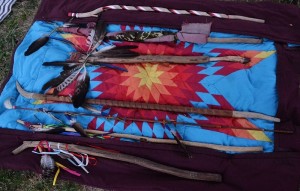 “The elders talk about embracing the ceremony to the point that those communities take ownership of the run. We hope runners from the community will meet us at their traditional territory line, and run their traditional territory with us. Then we, as core runners, focus on taking care of the staffs and supporting in different ways. We run as well, because once we start running we just have this love and passion for it.”
“The elders talk about embracing the ceremony to the point that those communities take ownership of the run. We hope runners from the community will meet us at their traditional territory line, and run their traditional territory with us. Then we, as core runners, focus on taking care of the staffs and supporting in different ways. We run as well, because once we start running we just have this love and passion for it.”
Daniel says it’s all about coming together and connecting as they go along, especially arriving in new communities at the end of the day’s run.
“We always love it when there’s someone there waiting for us who wants to help us walk in. It’s even better if they have runners that they send to help with the day, but if there’s someone there greeting us and helping us walk into the community, it’s a beautiful sight at the end of the day. We call it a pack run.”
As they make their way south, they are supported by different regions, each with its own organizers, all working towards guiding the runners, and arranging places for them to spend the night. Sometimes it’s in someone’s home, as was the case on Tuesday at the Elliot’s house in North Fork. Sometimes they are welcomed into community centers, gymnasiums, traditional spaces like long houses or smoke houses, and sometimes they bed down in campsites. But always, the mission is to connect with the communities through which they pass.
On the run from Mariposa, they were joined by a 9-year-old boy, whose mother served as part of the support team for the day. Runners come and go throughout the long journey, some for a few hours, some for a few months.
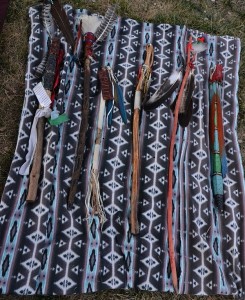 As the group settled in for the night in North Fork, they laid out their staffs before taking a well-deserved dip in the pool and enjoying a hearty dinner.
As the group settled in for the night in North Fork, they laid out their staffs before taking a well-deserved dip in the pool and enjoying a hearty dinner.
Each of the staffs has a story and is treated with reverence. The communities present them to the runners with a specific prayer and story of the intention behind them, and those stories are shared along the way. Once they reach Panama, each staff must be either retrieved by someone, returned to the community from which it came, or brought back in four years for the next run.
“Once they’re prayed over, it’s important for them to go back to the community, and share and let it radiate out,” says Daniel.
Eight years ago, the Elliot’s granddaughter Hadezbahbrisa, known as “Breezy,” was just 7 years old, when she learned that the runners would be coming through North Fork.
 “She put up a water booth with fruit and made little gifts for them,” says Breezy’s grandmother Jennifer. “Somehow in the middle of everything, she ran down to the house, and missed them. They ran past just in those few moments.”
“She put up a water booth with fruit and made little gifts for them,” says Breezy’s grandmother Jennifer. “Somehow in the middle of everything, she ran down to the house, and missed them. They ran past just in those few moments.”
Once they realized they had missed the group, the family packed up her little booth and they drove everything over to Auberry, the next stop on the Journey.
“We stayed the night with them and she ran with them the next morning. She was just seven,” says Jennifer.
On Tuesday, Breezy – now 15 – ran with Daniel and the group all the way from Mariposa.
“We were so proud of her,” says Lisa Elliot Benally, Breezy’s mom, “because we didn’t know until she arrived home with the runners that she was carrying the main staff.“
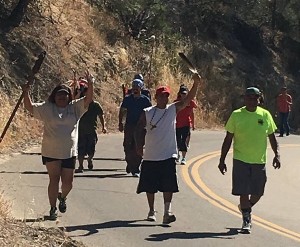
Big Sandy Community walks everyone to Auberry – photo shared by Li Eb on Central Valley Peace & Dignity Facebook page
After a sunrise circle at 5 a.m. on Wednesday, and breakfast and lunch served with joy by the Elliot family, the runners set off for Big Sandy near Auberry. That day’s run would be only 14 miles, but they were greeted by community members as they crossed into that territory. The next morning, they were off to Haslett Basin, then on to Choinumni Park in Piedra.
On Saturday, the group is scheduled to arrive at O’Neill Park at Fresno State University around 5 p.m., where they will be having a barbeque and raffle, and offering t-shirts and bandanas for sale to help sponsor their Journey.
As for the Elliots, Lisa says her family will be hosting these spiritual travelers more than once on their Journey.
“My mother’s family is from Costa Rica, and my aunt and uncle will be hosting them there,” says Lisa, “so they’ll pass through my family twice.”
Daniel is looking forward to experiencing the 4-day closing ceremony in Panama, scheduled to start on Nov. 14. Then, after more than six months of living on the road, the return to a “normal life” is likely to be a bit of a culture shock.
“Sometimes the toughest part of coming back home is – what do you do? You just went through this mind-blowing experience, and you’re back home in a room; you have a bed to sleep on; what do you do with that, it’s too comfortable. There’s a fridge! You’re not living in a van during the day, and there’s cold water on demand. Such convenience!”
The following is a list of the proposed dates of arrival for the Inland Southern California Route in the respected territories. Arrival Dates (usually arrive before 6 p.m., depending on how many stops and the distance):
July 12 – Tule River Tribe
July 13 – Tejon Indain Tribe (Bakersfield)
July 14 – Tatavium Band of Mission Indians (San Fernando)
July 15 – Tongva (LA)
July 16 – Tongva – Puvunga (Long Beach)
July 17 – Chino/Pomona (Tony Cerda Park – Costanoan Rumsen)
July 18 – San Manual Band of Mission Indians
July 19 – Sherman Indian School / Museum
July 20 – Soboba Band of Luiseno Indians
July 21 – Morongo Band of Mission Indians
July 22 – Mountain Cahuilla Bands – Cahuilla, Ramona, Santa Rosa
July 23 – Agua Caliente Band of Cahuilla Indians
July 24 – Torres Martinez Desert Cahuilla Indians
July 25 – Desert Center
For a map of the route into Southern California, click here.

